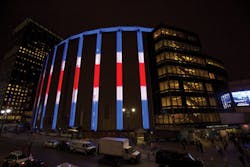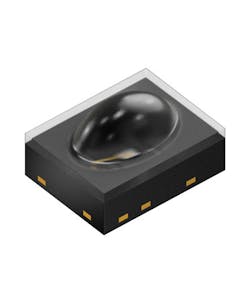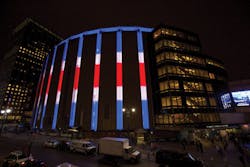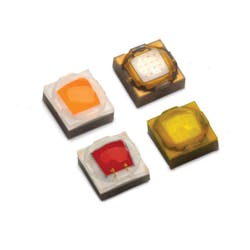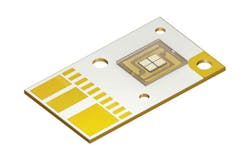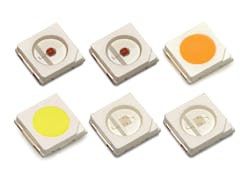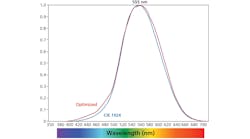Both monochromatic and phosphor-converted color LEDs are tracking near white LED performance, observes MAURY WRIGHT, and color adds impact to applications spanning façade lighting to automotive safety.
While phosphor-converted white LEDs are the new darlings of the general lighting world, color LEDs are serving in applications ranging from general lighting and automotive use to signage and projection. But listing those applications isn't sufficient to explain the scope of usage of both monochromatic and phosphor-converted LEDs that might find scores of different homes just in the modern car, even in surprising places such as a head-up display (HUD) like the one depicted in Fig. 1.
Interested in more articles & announcements on packaged LEDs?
Color adds a dynamic layer to most any conveyance of information, making communications more effective. The solid-state lighting (SSL) application set has kept a short list of LED manufacturers pushing color LED performance on a parallel track with white LED performance.
As you might expect, the demands of product developers for color LEDs track the needs in general lighting. Manufacturers are striving to deliver more output from smaller sources, increase energy efficiency, offer beam control options for varying applications, and simplify the mechanical structure of end products.
Let's dig deeper into applications for color LEDs and the special requirements for some of the applications. And we'll discuss some available products that are designed for specific applications. Indeed, we will cover both single-emitter packaged LEDs and products that integrate multiple emitters.
FIG. 1. Color LEDs project safety and directional clues into the driver's field of vision in a head-up display application.
When asked about the impact of color LEDs, Mike Martens, industry group lead for the NAFTA regions at Osram Opto Semiconductors, said the LEDs "take things that were once static like billboards and make it dynamic." That change can certainly make something like a billboard grab attention. But as you will see, it might also lead to better safety on the roadway. And without question, color will be key to manufacturers of different products looking to establish a brand identifier.
Video walls
The most dramatic example of color LED usage is probably in video walls that range in size up to the giant display at New York's Times Square or that can be found in sports arenas such as the huge video displays at AT&T Stadium in Dallas, TX, with the displays appearing to run the length of the football field.
Video walls can be realized with either discrete color LEDs or with packages that combine multiple emitters. Primarily, such displays use a red, green, and blue (RGB) LED mix, although some implementations add other colors for accents and possibly white to deliver more accurate white point in a display.
Osram serves the video wall application with the Displix family of LEDs (Fig. 2). The family includes triple-die packages with the RGB LEDs integrated, and discrete oval LEDs in yellow, red, green, and blue. And while you may expect some of the features that are present in the family specific to the application at hand, others will likely surprise you.
The LEDs are designed with optics intended to produce a wider beam horizontally than vertically - more closely matching the aspect ratio of typical screens. Indeed, the products have a 110° horizontal field and only a 60° vertical field. Osram also offers the LEDs in a black package to reduce reflections and boost contrast ratios, or in standard white packages. Martens from Osram also notes that the LEDs have to be able to withstand temperature extremes, torrential rain, and high humidity levels with such environmental protection designed into the packages.
Martens said the video wall technology also scales down in size to what are much more mundane applications yet that are critical in terms of safety. He said such smaller displays are used widely in Europe to implement roadside signs for electronic messages. The use of color LEDs "makes the signs more effective and efficient," according to Martens.
Architectural façades
Another popular application for color LEDs is in architectural façade lighting (Fig. 3). Such projects may use a single white hue, tunable white, fixed colors, or dynamic color mixing. Precise beam control is critical in such applications for a number of reasons - including the need to limit light spill or pollution. But the ability to produce uniform beams goes beyond light spill.
Lumileds, for instance, recently announced the Luxeon C family (Fig. 4) of color LEDs and has said beam uniformity was a guiding principle behind the development in which several lead customers worked closely with the LED manufacturer. In many such architectural lighting applications where colors are mixed, you may see a red halo or shadow or some other undesired effect.
David Cosenza, product manager for color LED products at Lumileds, explained that the problem with inconsistent beams in a mix of LEDs of various colors results from the fundamental LED architecture. Blue and green LEDs are generally based on an InGaN (indium gallium nitride) structure that is inherently different from the InGaAlP (indium gallium aluminum phosphide) platforms typically used in red and yellow LEDs. Moreover, white LEDs have an added phosphor layer, and some color LEDs are even made using blue emitters with phosphor conversion. The different architectures have also resulted in varying primary optics and beams that just don't match.
Optics and geometry
The issue comes down to simple geometry. Cosenza said, "Consistent focal height and optical symmetry across all colors" was the number one request from its lead customers for Luxeon C. The engineers behind the family worked with the various LED structures to ensure that the top of the emitter or z-height was exactly the same measured from the base on all Luxeon C products.
The precision carries on to the primary optics design. All of the LEDs use the exact same low-dome optic that is less than a full hemisphere. The dome design was optimized to deliver more punch in a tighter beam. The optic makes the effective source size smaller. For example, the new line will essentially supplant the long-tenured Luxeon Rebel color family that includes a full hemisphere dome. The design of Luxeon C presents a source that's only 23% as large as Rebel to the secondary optic yet delivers the full flux of a high-power architecture. Lumileds had recently also announced the Luxeon 3535L mid-power color LEDs with a small, flat emitting surface but clearly lacking the high flux of the high-power emitters.
FIG. 2. The Osram Displix color LEDs include an oval package designed to generate light over a wide horizontal area to better match the typical aspect ratio of video walls.
The identical design across the family also ensures that the same secondary optic, such as a total internal reflection (TIR) lens or a reflector, can be used with LEDs of various colors. In the past, SSL manufacturers have sometimes been forced to specify a different secondary optic for different colors used in a product.
There is one last element of the Luxeon C structure and optics that's important for color mixing and the target is crosstalk between densely-packed LEDs. With crosstalk, a photon from one LED might escape to the side, enter the optic of an adjacent LED, and be redirected inappropriately or even converted into the wrong color if the adjacent LED uses phosphor. The low-dome approach ensures photons aren't emitted outside the desired radiation pattern. And Lumileds applied titanium dioxide in the package to ensure no photons escape from the sides of the structure.
Emergency vehicle lighting
Now let's move to a vastly different application in emergency vehicle lighting. Most everyone from the LED manufacturer perspective agrees that the police, fire, and ambulatory markets are very important markets for color LEDs; and both mid- and high-power LEDs are used for light bars. In some cases, the light bars produce a color such as red or yellow that can be realized directly with color LEDs and at the same time some agencies mix colors to achieve colors such as purple.
At first thought, it would seem that attributes such as focal point and primary optics would not matter. But it depends on the product developer and end customer, according to manufacturers that supply the emergency field. Lumileds' Cosenza said even in the emergency application the ability of all the Luxeon C LEDs to work with the same secondary optic is an advantage. But we asked, wouldn't a broader beam pattern be preferred? Cosenza said in some instances developers use secondary optics with beam patterns as narrow as 2° in light bars. In other instances, he said developers may use the Luxeon 3535L LEDs with no primary optic.
Osram targets the emergency application primarily with its Oslon Signal high-power LEDs. The company offers the products in a range from 60° to greater than 120° beams using both low-dome and full-hemisphere primary optics. There are both monochromatic and phosphor-converted options in the family that includes white, amber, yellow, red, green, and blue LEDs.
Automotive applications
The mainstream automotive application brings yet more challenges and a truly broad set of uses. We will discuss standard exterior lighting, HUDs, cabin lighting, and exterior lighting required for emerging electric vehicles (EVHs) and in the future for autonomous autos.
LEDs have been prominently used for forward- and rear-facing signal lighting including turn indicators, reverse indicators, brake lights, and styling accents. We've covered the size of these markets in reports on Strategies Unlimited research presentations from Strategies in Light. Just the front and rear signal lights accounted for 15% of around $1 billion in LED revenue in 2014.
Automotive designers have utilized many different types of LEDs in such lighting, but there are some unique requirements. Lumileds' Cosenza pointed out that the auto application can place LEDs near an engine compartment where temperatures escalate. Moreover, he said the Luxeon C family has the best or most consistent hot and cold performance of any monochromatic LEDs on the market. Plus, Lumileds is the first company to hot bin and test color LEDs so developers can accurately project both color wavelength and flux output at high temperatures.
Martens from Osram said different optics concepts in automotive lighting can impact LED selection. For example, he said many of the signal lighting assemblies use light guides both to produce the desired light distribution and perhaps to add accent styling. He added that the Oslon Compact family of color LEDs is a good match for such applications because the LEDs do not have a lens and are designed to couple to a light guide. Moreover, the LEDs can be densely packed when required.
FIG 3. A popular application for color LEDs is in architectural façade lighting, such as this installation of dynamic Philips Lighting products at New York's famed Madison Square Garden.
Ultimately, the headlamp application will become the largest segment for LEDs in automotive applications, according to Strategies Unlimited. While there have been high-profile examples of LED-based headlamps such as the Audi Matrix, the technology has still proven too expensive for many auto models thus far. The author of the Developer Forum feature in this issue discusses the obstacle. We won't further discuss headlamps here, but a search on our website will reveal a number of articles on LEDs for headlamp applications.
HUD and future applications
Now let's talk about even more compelling applications for color LEDs in the interior of an auto. Simple HUD applications have been in autos for a while, providing data such as speed projected into the driver's field of view. The future implementations under development, however, use multiple LED colors to project far more data. Automotive OEM Continental has an excellent section on its website dedicated to what it calls augmented reality HUD or AR-HUD.
AR-HUD uses colors to convey information more impactfully for the driver. Red indicators can warn of hazards or lane departure. Blue might be used to indicate spacing to an auto in front of the driver's position. And in such a situation, the HUD system provides data at seemingly different depths of field. Data such as speed appear close to the driver, while spacing between cars or even guidance from an integrated GPS appear further up the road to the driver's vision system.
Kimberly Peiler, Osram's applications engineering manager, said the company will enable HUD systems with a larger field of view with the Ostar Projection LED portfolio designed for projector applications. The products include both single-color LEDs and multiple-emitter LEDs with RGB capability. In particular, the P2W 01 LED (Fig. 5) is appropriate for such applications with four emitters controllable as two pairs in a more compact form factor. That product was announced back in April.
The key to the projection application, according to Peiler, is maximum luminance relative to emitting area. The Ostar line is based on Osram's UX:3 technology platform that the company refers to as ThinGaN in some instances. UX:3 is essentially a flip-chip architecture with the n-layer on the top side of the chips and an array of conductive vias that connect with the n-layer contact on the underside of the chip. The architecture provides uniform current spreading and emission. Peiler said that 3-A/mm2 current density is possible and a 1-mm2 chip driven at 3A delivers 3.2W in radiometric power or 830 lm in phosphor-converted white.
EVH and autonomous indicators
Other evolving automotive applications may not be quite so dramatic but still indicate the importance of high-output color LEDs that are clearly visible in sunlight. For example, we recently covered the extreme case of display panels now being used on the sides of IndyCar open-wheel racers. Where else might exterior auto displays be needed?
FIG. 4. Luxeon C color LEDs from Lumileds feature identical primary optics and focal height across the phosphor-converted and monochromatic range.
Osram's Peiler said easily readable displays are needed on the exterior of an EVH because the owner will need to be able to determine the charge status of the auto when considering whether to connect to or disconnect from a power source. The display might convey information using color or intensity or both.
The eventuality of autonomous vehicles that operate without a driver will yield even more special requirements, claimed Peiler. Front and rear displays will communicate to pedestrians and/or other drivers. For example, such a display could indicate to a pedestrian that an autonomous vehicle has detected their presence and that it is safe for the pedestrian to cross the road, just as a human driver might utilize the wave of a hand in recognition.
Monochromatic and phosphor converted
Throughout our discussion of color LED applications here, we've mentioned the fact that such products can be monochromatic, producing a color natively; or they can use phosphor conversion, much like a white LED. It's certainly necessary to briefly discuss why both options are important and why LED manufacturers have these options in their product portfolios. The reasons include efficiency, light quality, color accuracy, thermal performance, and flexibility, among others.
Green LEDs are a good place to start because it's well known that monochromatic green LEDs lag red and blue LEDs significantly in efficiency. A phosphor-converted green LED can close the efficiency gap. But there are other factors that come into play as well.
Lumileds, for example, has touted the phosphor-converted lime-color LEDs used in the color-tunable Hue lamps as critical to the ability of the devices to produce warm-white light with a reasonably high CRI. The use of phosphor delivered both light-quality benefits along with efficiency. A lime LED is part of both the Luxeon 3535L (Fig. 6) and C portfolios.
Other applications, however, will need the true narrowband emission of a monochromatic green LED. Lumileds' Cosenza said you get more saturated green colors and better yellows in color-mixing applications using a monochromatic green. He said Lumileds can deliver the most efficient direct green on the market, having reduced forward voltage to 2.55V while competitors are in the 3-3.5V range, affording a presumed 10% advantage in efficacy with this color LED.
Thermals and color palette
Factors such as thermal environment can also impact whether a monochromatic or converted color source is the best choice in an application. Osram, for example, has phosphor-converted yellow LEDs. Martens said the company has nearly matched blue (InGaN) power output in red and yellow InGaAlP LEDs. But he admitted the performance of the latter falls off to a greater degree in terms of light output in a higher-temperature environment. So a phosphor-converted InGaN LED can prove superior in such applications.
FIG. 5. The latest Osram Ostar Projection color LED includes four emitters with the ability to drive the emitters in two independent pairs.
FIG. 6. Mid-power Lumileds Luxeon 3535L color LEDs use phosphor conversion for the amber (top right) and lime (bottom left) LEDs.
Phosphor also provides the ultimate flexibility in terms of a color palette. Consider that Osram offers a phosphor-converted blue LED in a color called Ice Blue. At first, the concept seems confusing given that monochromatic blue LEDs are the most efficient emitters produced. But some auto makers are using shades such as Ice Blue in ambient interior lighting as a signature brand identifier for an exclusive look.
Indeed, Osram has offered what it calls Color on Demand through phosphor. Large-volume customers can specify a chromaticity and use that color exclusively. Osram also said phosphor conversion can deliver better yellow performance for stage and entertainment lighting and better green performance for projection.
Of course, there are far more applications for color LEDs than we have covered here. We have deliberately omitted discussion of the horticultural LED lighting application since we covered it in a recent feature. In that article, we mentioned some Osram LEDs designed specifically for horticulture, and Lumileds has added similar deep- and far-red LEDs in the Luxeon C line.
The other application that we only briefly discussed here is tunable general illumination. Of course, that is a market with huge potential and will use RGB LEDs - and potentially other colors. Lumileds' Cosenza said the company has customers designing 5-8 channel systems. The color LED market is clearly poised for growth. The most interesting angle going forward, however, may well be how performance of such LEDs tracks the workhorse blue emitter used in white lighting for general illumination applications.
Breaking news
Cree announces XQ-E HI color LED family based on SC5
Just as this issue went to press, Cree made a major color LED announcement with High Intensity (HI) versions of the XLamp XQ-E product family that have also been upgraded to the SC5 (silicon carbide 5) technology platform. Like the Lumileds Luxeon C LEDs, the Cree XQ-E HI features a relatively flat primary optic that can produced tighter beams with higher center beam candle power.
